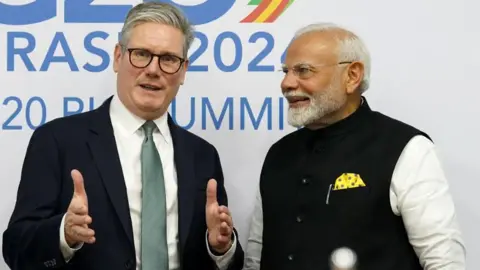In a significant development in international trade, the United Kingdom has successfully secured a landmark free trade agreement with India, a nation that has recently surpassed China to become the world’s most populous country. This trade deal, heralded as Britain’s largest post-Brexit agreement, promises to unlock new economic opportunities between the two nations, facilitating greater export potential and bolstering key sectors of the UK economy.
The deal is particularly favorable for British exports such as whisky and vehicles, which will benefit from substantial reductions in tariffs that had previously acted as barriers to trade. Notably, while the agreement allows for the elimination of 99% of tariffs on Indian exports to the UK, it does not lead to a complete absence of tariffs on British goods entering India. Approximately 85% of British exports will remain free from tariffs, while India continues to maintain a highly protective stance on its economy, reflecting its longstanding import restrictions.
Despite these protective measures, the UK government anticipates significant gains from the deal, projecting an addition of £15 billion to British exports and approximately £10 billion for India by the year 2040. This enhancement in trade is anticipated to evolve as Indian imports, particularly in the automotive sector, increase due to the newly allowed tariff-free importation of up to 88,000 cheaper Indian vehicles into the UK market.
Trade Secretary Jonathan Reynolds described the agreement as a “win-win” that supports exporters, generates employment opportunities, and provides lower prices for consumers. The UK government’s broader strategy encompasses creating a “most connected market in the world,” with aspirations for further dealings with the United States, pragmatic adjustments regarding China, and potential agreements with Gulf nations. This ambitious pursuit is set against the backdrop of a challenging global trade landscape, characterized by tensions between the US and China, which have recently engaged in a contentious trade war marked by widespread tariffs under the Trump administration.
The historical significance of the UK-India trade deal cannot be understated. Efforts to cultivate deeper economic ties between the two nations have faced hurdles for decades. However, the current government views the agreement as a turning point that moves past years of underutilized opportunities, capitalizing on the enduring cultural and economic connections that have characterized UK-India relations.
Furthermore, the agreement reflects broader shifts in global trade dynamics, positioning the UK and India closer together as they seek mutual benefits in an environment where larger economies grapple with sustaining their trade relations amid increasing tariffs and regulatory constraints. The newfound alliance is illustrative of how nations can pivot towards one another to bolster economic resilience, particularly in the face of challenging geopolitical climates.
Overall, the UK-India trade agreement marks a pivotal moment in post-Brexit Britain, one that extends beyond simple economic figures. It encapsulates a vision of renewed partnership and cooperation, offering pathways to enhance trade, create jobs, and foster innovation across sectors while navigating the complexities of the global economy. As both countries move forward with implementation, the implications of this monumental agreement will likely resonate throughout the global trading landscape, setting a precedence for future collaborations.



